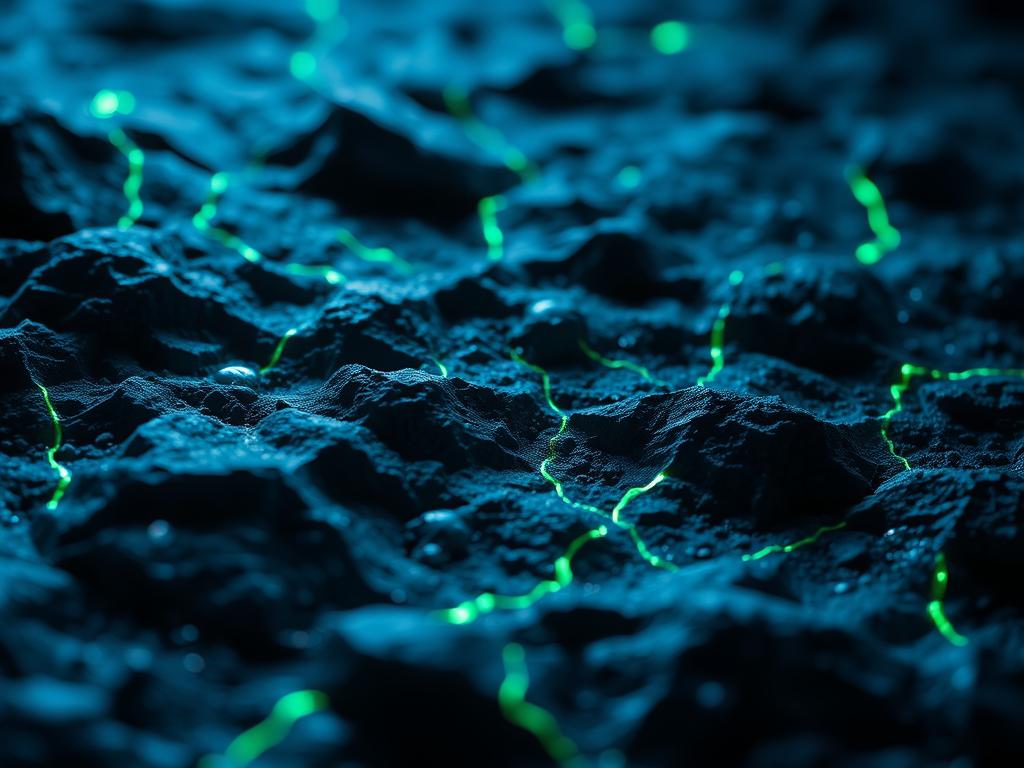Surface roughness in semiconductor devices can greatly affect electron mobility. As devices get smaller, understanding this issue becomes vital for advancing semiconductor technology.
A 2018 study showed surface roughness impacts silicon nanowires’ conductance. This effect grows stronger as devices shrink. These findings are crucial for developing future nanoelectronics and high-speed transistors.
Surface topography is key to semiconductor device performance. As nanowires shrink from 10-100 nm to 1-5 nm, electron transport behavior changes. This shift can cause electrons to become trapped due to disorder, even at room temperature.
Surface roughness affects more than just nanowires. In quantum wires, theories predict changes in electron behavior as concentration increases. This could lead to creating ballistic nanowires, potentially supporting quantum computation.
Researchers are exploring different surface roughness models to tackle these issues. They’re using Gaussian and exponential approaches to improve electron transport in quantum wires.
By studying surface roughness scattering, we can boost electron mobility. This research will help create faster and more efficient electronic devices in the future.
Understanding Surface Roughness and Its Implications
Surface roughness is vital in electronics and material science. It refers to tiny surface irregularities that impact device performance. These small imperfections are especially important in nanoscale electronics.
Definition and Importance in Electronics
Surface roughness measures deviations from a smooth surface. In nanowire fabrication, microscopic flaws have big effects. They can cause damage and corrosion, affecting electronic component function.
Measurement Techniques for Surface Roughness
Accurate surface roughness measurement is key for quality control. Common techniques include:
- Stylus-based methods: Provide accurate readings but may cause micro-scratches
- Optical instruments: Non-contact methods offering precision assessment
- Atomic force microscopy: Delivers high-resolution surface mapping
These methods quantify parameters like Ra (average roughness) and Rz (maximum height profile). These measurements are crucial for surface metrology.
Effects on Electron Mobility
Surface roughness greatly affects electron transport in semiconductors. Rough surfaces scatter electrons, reducing mobility and increasing power use. This effect is strongest in nanowires with small diameters.

Surface roughness is key to optimizing electronic device performance. It affects electrical conductivity and wear resistance. This makes it crucial in designing advanced electronic components.
| Surface Finish Component | Description |
|---|---|
| Lay | Predominant surface pattern direction |
| Waviness | Larger-scale surface deviations |
| Flaws | Random irregularities like scratches or cracks |
| Roughness | Fine-scale surface texture |
Mastering surface roughness is crucial as electronics get smaller. It’s key to improving device performance and reliability. Understanding this concept helps advance electronic technology.
The Science of Scattering in Semiconductor Devices
Surface roughness impacts electron mobility and device performance in semiconductors. It affects scattering mechanisms in advanced electronic components. Let’s explore how surface irregularities influence these processes.
How Surface Roughness Affects Scattering
Surface roughness disrupts electron flow in semiconductor devices. It breaks translational symmetry, relaxing momentum conservation conditions. This leads to increased scattering, impacting device performance.
The effect is particularly noticeable in quantum cascade lasers and other high-speed electronic components. These devices rely on smooth electron flow for optimal function.
Key Factors Influencing Scattering Rates
Several factors affect scattering rates in semiconductor devices:
- Conduction band offset
- Quantum well and barrier thicknesses
- Scale of surface non-uniformities
- Electron concentration
Surface dimensionless conductivity initially decreases with growing 2D electron concentration. It follows the relationship ‘/n^6= 5’ before reaching saturation. This shows the complex interplay between electron density and scattering mechanisms.
Common Scattering Mechanisms
Various scattering mechanisms occur in semiconductor devices, including:
- Interface roughness scattering
- Rayleigh scattering
- Mie scattering
- Diffraction
Interface roughness scattering is significant in devices with large conduction band offsets. This includes mid-infrared quantum cascade lasers using InGaAs/InAlAs alloys. It causes both intrasubband and intersubband electron scattering.
| Scattering Mechanism | Primary Cause | Effect on Device Performance |
|---|---|---|
| Interface Roughness | Surface irregularities | Reduced electron mobility |
| Rayleigh Scattering | Small particles | Wavelength-dependent loss |
| Mie Scattering | Larger particles | Less wavelength dependence |
| Diffraction | Edge effects | Signal spreading |
Grasping these scattering mechanisms is vital for improving semiconductor device performance. It helps push the boundaries of electronic technology. Researchers continue to explore ways to minimize scattering effects.
Practical Applications Across Industries
Surface roughness scattering impacts device performance and efficiency in many industries. It’s crucial for advancing technology in multiple sectors. Understanding its effects is key to improving various devices.
Enhancing Performance in Microelectronics
In nanoelectronics, minimizing surface roughness is vital for improving device performance. This is especially true for nanoscale and quantum dot transistors. Even small imperfections can greatly affect electron mobility in these devices.

Impacts on Photovoltaics and Energy Devices
Surface roughness significantly affects photovoltaic cells and energy devices. It influences charge carrier transport and light absorption. Scientists are working to optimize surface textures for better energy conversion.
This research focuses on improving solar panels and photocathodes. The goal is to enhance their overall efficiency through surface modifications.
Implications for High-Speed Communication
Surface roughness scattering can hinder terahertz quantum cascade lasers in high-speed communication systems. These lasers could power future ultra-fast communication networks. Reducing surface scattering is essential for boosting their performance.
This improvement would increase their maximum operating temperature and efficiency. It’s a critical step in developing faster communication technologies.
| Application | Impact of Surface Roughness | Improvement Goal |
|---|---|---|
| Nanoelectronics | Affects electron mobility | Enhance transistor performance |
| Photovoltaics | Influences charge transport | Increase energy conversion efficiency |
| Terahertz Lasers | Limits operating temperature | Improve communication speed |
Advancements in surface roughness control are driving innovation across these industries. A recent study on surface scatter phenomena highlights its importance. Minimizing surface roughness is crucial for pushing technology boundaries in various applications.
Strategies for Minimizing Surface Roughness Scattering
Surface roughness scattering creates major issues in semiconductor devices. Engineers use various methods to reduce its impact on electron mobility. These strategies aim to improve overall device performance.
Advanced Fabrication Techniques
Molecular beam epitaxy is a powerful tool for reducing surface roughness. It allows precise control over growth parameters, creating smoother interfaces between layers. This technique helps manufacturers produce high-quality AlGaAs heterostructures with fewer surface irregularities.
Surface Treatment Methods
Interface grading techniques help smooth out abrupt transitions between layers. This approach gradually changes material composition, reducing sharp conduction band offset discontinuities. Gentle polishing of ridge waveguides in lithium-niobate-on-insulator substrates can significantly decrease scattering losses.
Innovative Material Choices
New materials can lead to better device performance. GaAs/AlxGa1-xAs compounds with x>0.15 show promise for terahertz quantum cascade lasers. These materials offer improved temperature stability and reduced electron leakage.
Balancing benefits with potential increases in interface roughness scattering is crucial. Careful consideration of quantum well and barrier thicknesses is necessary.
| Surface Type | RMS Roughness (nm) | Typical Application |
|---|---|---|
| Low-quality optics | ~10 | Basic illumination |
| Precision quality optics | ~2 | High-performance devices |
| Ultra-smooth surfaces | ≤1 | Advanced semiconductor applications |
These strategies can greatly reduce surface roughness scattering in semiconductor devices. Implementing them leads to enhanced electron mobility and improved performance. These improvements benefit various semiconductor applications.
Future Trends in Surface Roughness Research
Surface roughness research is on the brink of major breakthroughs. New technologies and materials are set to transform our understanding of this vital phenomenon. The nanoscale realm offers exciting possibilities for creating atomically perfect surfaces.
These advances could greatly improve electron mobility and device performance. The potential for enhancing various applications is immense.
Emerging Technologies and Materials
2D materials lead the charge in this revolution. They offer unparalleled control over surface properties. Graphene and transition metal dichalcogenides provide ideal platforms for studying surface roughness effects.
Recent studies show promising results with rare earth elements. When added to thin films, they can significantly change surface morphology and roughness. This could lead to better magnetic and electrical properties.
The Role of Machine Learning and AI
AI and machine learning will be crucial in optimizing surface roughness. These tools can analyze vast datasets from advanced characterization techniques. They can predict the best fabrication parameters and material compositions.
This data-driven approach could speed up the development of smoother surfaces. Applications range from high-speed electronics to quantum computing devices.
Challenges and Opportunities Ahead
Despite the promising future, significant challenges remain. Achieving atomically smooth surfaces in complex structures is still difficult. Maintaining these surfaces under various conditions is also challenging.
Research shows that temperature affects magnetic components. Decreased magnetic anisotropy occurs around 350 °C. Balancing performance improvements with manufacturability will be crucial.
However, the opportunities are vast, especially in quantum computing. Atomically precise surfaces could unlock new levels of computational power. This could lead to unprecedented efficiency in various fields.


